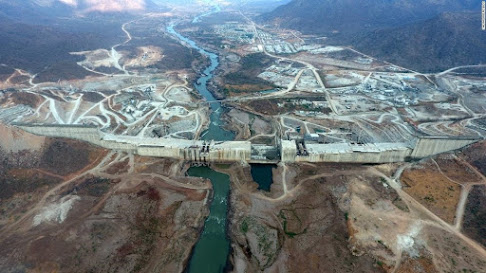An African Spring
“Egypt sees the dam as an existential threat to its
survival, a concern shared, albeit to a s lesser extent, by Sudan. Ethiopia, on
the other hand, regards the dam as vital for its energy needs.” (Chothia,
2020)
Egypt and Ethiopia’s current conflict pertains to the aforementioned
‘water war’ presented in Frey (1993) in which Egypt perceives their goals as
being blocked by Ethiopia and vice versa. The GERD undoubtedly challenges Egypt’s
hegemonic position over the Nile resources and Ethiopia’s decision to build the
GERD without consultation with other riparians may be viewed as a subversive
yet passive revolt against the anachronistic, inequitable and injudicious
allocations of resources by colonial powers. Challenging this power has been
described as ‘an African Spring’ (Tawfik, 2016) pertaining to the uprising of the
Arab spring in late 2010 challenging oppressive regimes, legislations and practices
in the Maghreb. Whether the GERD was an extreme response to the legacies of power
imbalance over the Nile is highly debatable, however, it does beg the question
of whether Ethiopia can meet its need whilst fulling the promises to “transcend
the mistakes of the past [that would]…constrain the present and hinder [unification]
aspirations for the future” (Tawfik, 2018) during the Khartoum framework cooperation
deal on the GERD.
Why did Ethiopia choose to build the dam? The 1929 Anglo-Egyptian
Treaty provisioning the allocation of water rights along the basin was signed
by the United Kingdom, former colonial power, which guaranteed an annual supply
of 48 billion and 4 billion cubic metres to Egypt and Sudan respectively out of
the estimated annual 84 billion cubic metres of Nile water. This was further reallocated
in 1959 which increased Egypt’s share to 55.5 billion cubic meters and Sudan’s
to 17.5 billion (Harb, 2019) with the additional veto power assigned to Egypt. “Nile
Basin Initiative demographic projections for 2050 put Egypt’s and Sudan’s
populations well below those in some of the eight other countries in the
initiative, making the old water agreements appear less fair every day” (Harb,
2019), these agreements set the premise for localised tensions and future conflicts
as the population growth as well as the developmental needs of the riparian
states along the river were insufficiently forecasted or looked over. Decades later,
Ethiopia set to build the largest hydroelectric dam in Africa, its ties with China
have become stronger, business and industrial prospects have soared and an
opportunity to lift a significant population out of extreme poverty emerges.
The GERD not only has the opportunity to generate income and tackle poverty by
providing electricity to 66% of the population, expanding the access to clean
water and regulating river flow to maximise production- but completely transform
Ethiopia and place it on level playing field with middle-income countries by 2025.
The installation of the GERD has a host of indirect and inter-generational impacts
on the population of Ethiopia however, the surplus energy provided by the dam
with generation further income from the expansion of industrial sector and the exportation
of energy to neighbouring countries (Woldetatyos, 2020). With so many positives for an individual
riparian along a basin as wide as the Nile it makes the objections against the
stagnation of economic prosperity and poverty reduction particularly difficult
by the international community, thus Egypt’s once passive aggressive stance against
the project is essence is an impending war.
References
Tawfik, R. (2016). “Reconsidering counter-hegemonic dam
projects: the case of the Grand Ethiopian Renaissance Dam”. Water Policy,
18(5), pp.1033-1052.
Frey, F., 1993. The Political Context of Conflict and
Cooperation Over International River Basins. Water International,
18(1), pp.54-68.
Chothia, F. (2020). Trump And Africa: How Ethiopia Was
'Betrayed' Over Nile Dam. BBC News. Available at:
https://www.bbc.co.uk/news/world-africa-54531747.
Tawfik, R. (2018). Blogpost: Eastern Nile cooperation at a
crossroads: the costs of missing another opportunity. Kujenga Amani.
Harb, I. (2019). River of the Dammed. Blogpost: Foreign
Policy. Available at: https://foreignpolicy.com/2019/11/15/river-of-the-dammed/.
Woldetatyos, F., 2020. 10 ways the GERD will reduce poverty
in Ethiopia. Blogpost: The Borgen Project, Available at: https://borgenproject.org/ethiopias-gerd/.

i like how you started the blog with a quote, really good introductory paragraph.
ReplyDeleteyou explained the politics of how Ethiopia would benefit from the building of the GERD.
area to improve:
- i think it would be really good if you went more into the politics of the effects of the dam on the lower riparians and how the GERD is fraught with politics due to its effects downstream.